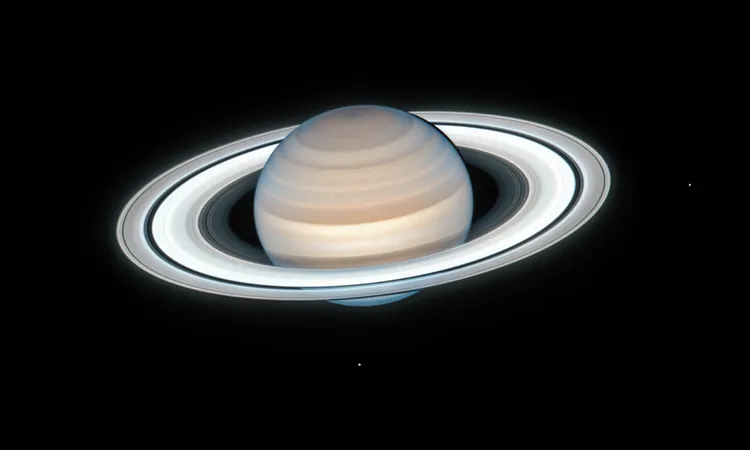
Saturn's Rings: Set to Disappear for Months! Here's What You Need to Know!
2025-01-12
Author: Ying
Saturn, the stunning jewel of our solar system, is famous for its magnificent rings, captivating the imaginations of stargazers for centuries. From the humble observations of Galileo Galilei in the 17th century—who mistook the rings for 'ears'—to today's advanced telescopes, our understanding of this gas giant has evolved dramatically.
The Mystique of Saturn’s Rings
Modern advancements in astronomical technology have unraveled the complexities of Saturn's rings, consisting mainly of ice and rocky debris that orbit the planet in vast arcs. Not only are these rings breathtaking, but they also play a crucial role in unraveling the mysteries of gravitational dynamics within our solar system.
Researchers, including Jonah Peter, a Harvard-Smithsonian Center for Astrophysics doctoral student, focus on how Saturn's moons interact with these rings, shaping the environment and providing insights into cosmic gravitational behavior.
The Great Disappearance: What to Expect
On March 23, 2025, a rare phenomenon will occur: a 'ring plane crossing.' During this event, Saturn’s rings will appear to vanish as their thin edges align directly away from Earth, making the majestic planet look like just a pale yellow sphere. This incredible cosmic coincidence happens due to Saturn’s axial tilt and its position in orbit, leaving enthusiasts both disappointed and intrigued.
The rings won’t be gone forever! They will reemerge in full view around November 2025. This cyclical behavior serves as a poignant reminder that while planetary features may change, the wonders of the universe remain constant.
Understanding the Composition of Saturn's Rings
Saturn's rings are not uniform; they’re classified into sections—A, B, C, and fainter D, E, F, and G rings—distinguished by varying densities and material compositions. The well-known Cassini Division, lying between the A and B rings, illustrates how gravitational forces create gaps in the ring structure, with particles ranging from dust-sized flecks to massive boulder-like formations.
There are theories suggesting that these rings could have originated from a moon that was torn apart by Saturn’s gravitational pull or remnants from the planet's formation four billion years ago.
The Role of Moons
Saturn is adorned with at least 145 moons, some functioning as shepherd moons that help maintain the organization of ring particles through their gravitational influence. Titan, Saturn’s largest moon, has been a focal point in the search for extraterrestrial life due to its thick, nitrogen-rich atmosphere and intriguing geological features, including lakes of liquid hydrocarbons.
Excitingly, NASA's upcoming Dragonfly mission aims to explore Titan's surface to uncover its mysteries, which could revolutionize our understanding of chemistry and the possibility of life in hostile environments.
Searching for Life in Mysterious Places
Another moon, Enceladus, has sparked intense interest among astrobiologists because it has demonstrated hydrothermal activity and ejected icy plumes that suggest the presence of water vapor. The findings from the Cassini mission have fueled speculations that Enceladus may harbor the essential ingredients for life.
Conclusion: Saturn's Enduring Mystique
As we gear up for the temporary disappearance of Saturn's iconic rings, it’s a reminder of the cyclical nature of our universe. While Saturn may lose its rings from view for a while, they will return, fascinating astronomers and enthusiasts alike.
Our quest to understand Saturn and its surroundings continues. With each observation, regardless of ring visibility, we edge closer to unlocking the secrets of this majestic planet. Stay tuned to the skies—there's always more to discover!
If you're passionate about space, don’t forget to subscribe for more exploration stories and cosmic updates!
 Brasil (PT)
Brasil (PT)
 Canada (EN)
Canada (EN)
 Chile (ES)
Chile (ES)
 Česko (CS)
Česko (CS)
 대한민국 (KO)
대한민국 (KO)
 España (ES)
España (ES)
 France (FR)
France (FR)
 Hong Kong (EN)
Hong Kong (EN)
 Italia (IT)
Italia (IT)
 日本 (JA)
日本 (JA)
 Magyarország (HU)
Magyarország (HU)
 Norge (NO)
Norge (NO)
 Polska (PL)
Polska (PL)
 Schweiz (DE)
Schweiz (DE)
 Singapore (EN)
Singapore (EN)
 Sverige (SV)
Sverige (SV)
 Suomi (FI)
Suomi (FI)
 Türkiye (TR)
Türkiye (TR)
 الإمارات العربية المتحدة (AR)
الإمارات العربية المتحدة (AR)